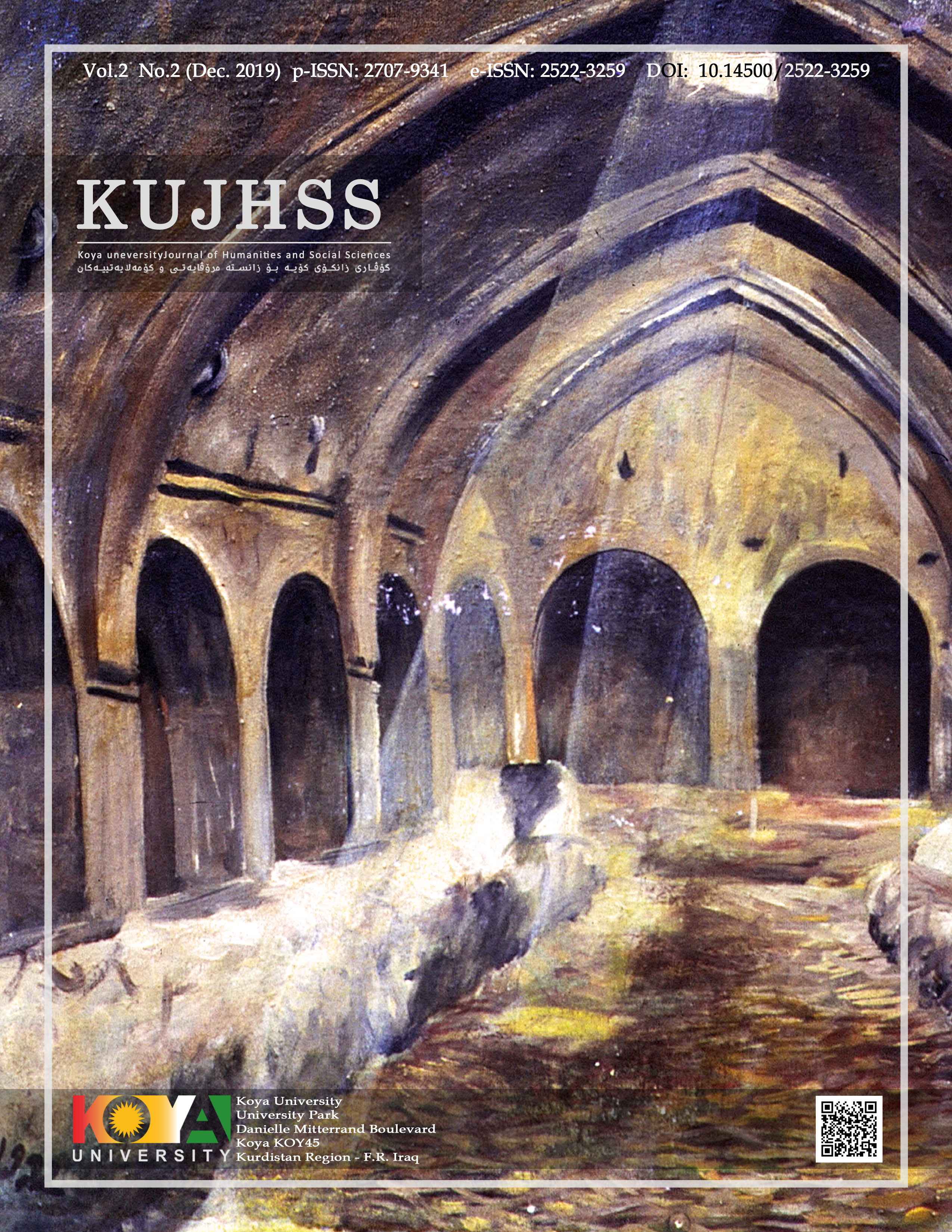خودچالاكى لای مامۆستایانى زانكۆى كۆيە بەپێی هەندێک گۆڕاوى دیمۆگرافی
DOI:
https://doi.org/10.14500/kujhss.v2n2y2019.pp87-93الكلمات المفتاحية:
ديموگرافى، زانكۆى كۆيە، مامۆستا، SPSS، خودچالاكىالملخص
ئامانجهكانی ئهم توێژینهوه خۆی لهدوو بهش دهبینێتهوه، ئامانجی گشتی توێژینهوهكه، كه بریتی یه لهزانینی ئاستی خودچالاكی مامۆستایانی زانكۆ، و ئامانجی تایبهتی كه بریتییه له زانینی كاریگهریی جیاوازی ڕهگهز لهسهر ئاستهكهیان، ئینجا زانینى پهیوهندى خودچالاكی مامۆستایانى زانكۆ بۆ یهكێك له گۆڕاوه دیمۆگرافیهكانی ڕاپرسی توێژینهوهكه، كهبریتییه له گۆڕاوی بڕوانامه، بۆ بهدهستهێنانی ئهم ئامانجه گشتی و تایبهتیانهی توێژینهوهی بهردهست، 72 مامۆستای زانكۆ بهشێوهیهكی ههڕهمهكی خۆبهخشانه بهشداریان كرد. بۆ كۆكردنهوی زانیاری توێژینهوهی بهردهست ڕاپرسیهكی 10 بڕگهیی وهرگیراو بهكارهات كه 5 ههڵبژاردنی ههیه، لهبهرامبهر ههر بڕگهیهك بهشێوهیهكی یهكسانی ئاماژهی پێكرابو تاكو بهشداربو بهئاسانی بتوانێت ئهو وهڵامه ههڵبژێرێت كهلهگهڵ بۆچونی تایبهتی خۆی دهگونجێت، بۆ دڵنیایی بون لهبههای ڕاستگۆیی و جێَگیری ئامرازی كۆكردنهوهی زانیاری توێژینهوهكه، ڕاپرسیهكه لهماوهیهكی كورتدا كه لهڕۆژێك زیاتر نهبو بهسهر بهشێك له نمونهی توێژینهوهكه دابهشكرا پاش كۆكردنهوهی ڕاپرسیهكان و دابهزاندنی بۆ سهر بهرنامهی ئاماری تایبهت، داتاكان شیكردنهوهیان بۆ ئهنجامدرا، پاشان دهركهوت كه بههاكهیان لهئاستێكی گونجاودایه بهمهش تویژینهوهكه بهردهوامی پێدرا بۆ دابهشكردن بهسهر نمونهی كۆتایی . پاش كۆكردنهوهی زانیاری له نمونهی كۆتای توێژینهوهكه ئینجا شیكردنهوهیان به بهرنامهی spss ههگبهی ئاماری بۆ زانسته كۆمهڵایهتییهكان كه تایبهته به بواری دهرونی و پهروهردهی كۆمهڵایهتی مرۆڤایهتی، ئهنجامهكان دهریانخست كه ئاستی گشتی خودچالاكی پهروهردهیی مامۆستایانی زانكۆ لهئاستێكی بهرزدایه، بهڵام هیچ جیاوازیهكی بهڵگهداری ئاماریی له ئاستی خودچالاكی مامۆستایان دهرنهكهوت لهنێوان ههردوو ڕهگهزی جیاوازی نێر ومێی بهشداربوانی توێژینهوهكه، ههرچهنده ئهنجامەکانی توێژینهوهكه ئاماژه بهوهدهكهن كه، ئاستی خودچالاكی ڕهگهزی مێ ئاستهكهیان بهرزرتر بو بهڵام بهڵگهداری ئاماریی نهبوو. لهكۆتایی ئامانجە تایبهتیهكان دهریانخست كه پهیوهندییهكی نهرێینی لهنێوان بڕوانامه وئاستی خودچالاكی پهروهدهییان ههیه، واته ههرچهنده بڕوانامه بهرزتر بێت ئاستی خودچالاكیان نزمتره، بهڵام ئهم پهیوهندییه لهئاستی بهڵگهداری ئاماریی نهبو. لهکۆتایی ولهژێر ڕۆشنایی ئهنجامهكان چهندین پیشنیاز و ڕاسپارده پێشكهشكران.
التنزيلات
المراجع
أبو العلا، مسعد (٢٠٠٤). الكفائة الذاتية للمعلم وعلاقتها بمفهوم الذات ومركز التحكم في ضوء متغيري الجنس والخبرة السابقة، مجلة التربية – كلية التربية جامعة اللازهر.
أبو شعيرة، خالد " غباري، ثائر (٢٠٠٥). علم النفس التربوي وتطبيقاتة الصفية، الطبعة الاْولى، الاردن.
أبوجاد، صالح محمد على (٢٠٠٥). علم النفس التربوي، الطبعة الرابعة، دار المسيرة للنشر والتوزيع، عمان الاردن.
أسعد، وليد (٢٠٠٥). الادارة الصفية، الطبعة الاولى، عمان.
عبد الجواد، أحمد سيد عبد الفتاح (٢٠٠٦). فعالية الذاتية الارشادية لدى ألاِخصائي النفسي المدرسي وعلاقتها ببعض عوامل المناخ المدرسي، كلية التربية جامعة الفيوم، قاهيرة، رسالة ماجستير منشورة.
العلوان، أحمد فلاح (٢٠٠٩). علم النفس التربوي تطوير المعلمين، الطبعة الاولى، كلية العلوم التربوية جامعة الحسين بن طلال، الاردن.
Armor, D., Conroy-Osefuera, P., Cox, M., King, N., McDonnell, L., Pascal, A., Pauly, E., & Zellman, G. (1978). Analysis of the school preferred reading programs in selected Los Angeles minority schools. Report no. R-2007-LAUSD. Santa Monica, CA: Rand (Eric Document reproduction service no: ED 130 243). retrieved on 8 Nov, 2016 at: https://files.eric.ed.gov/fulltext/ED130243.pdf
Aurah, C.M. & McConnell T.J. (2014). Comparative Study on Pre-Service Science Teachers’ Self-Efficacy Beliefs of Teaching in Kenya and the United States of America; USA. American Journal of Educational Research, Vol. 2, No. 4, Pp. 233-239. Retrieved on 26 Sept. 2018 at http://pubs.sciepub.com/education/2/4/9
Bandura, A. (1986). Social foundations of thought and action: A social cognitive theory. Englewood Cliffs, NJ: Prentice Hall.
Bandura, A. (1995). Exercise of personal and collective efficacy in changing societies: Cambridge, U.K.: Cambridge University Press.
Bandura, A. (1997). Self-efficacy. The exercise of control. New York
Caprara, G. V., Barbaranelli, C., Steca, P., and Malone, P. S. (2006). Teachers' self-efficacy beliefs as determinants of job satisfaction and students' academic achievement: A study at the school level, Journal of School Psychology, Vol. 44:2 6, Pp. 473–490. Retrieved on 26 Sept. 2018 on: www.sciencedirect.com/science/article/pii/S0022440506000847
Elizabeth A. L & Paul R. P. (2003) The Role of Self-Efficacy Beliefs in Student Engagement and Learning In the classroom, Reading & Writing Quarterly, Vol. 19:2, Pp.119-137, DOI: 10.1080/10573560308223. Retrieved on 26 Sept, 2018 on: www.tandfonline.com/doi/abs/10.1080/10573560308223
Finnegan, R.S. (2013). Linking Teacher Self-Efficacy to Teacher Evaluations. Journal of Cross-Disciplinary Perspectives in Education Vol. 6, No. 1 Pp. 18 – 25. Retrieved on 23 Sept. 2018 at: https://pdfs.semanticscholar.org/6c63/2b28ee3ba138637fba69a3fb563bcabc7fcb.pdf
Griethuijsen, R. A. L. F., Eijck, M. W., Haste, H., Brok, P. J., Skinner, N. C., Mansour, N., Gencer, A. S., BouJaoude S. (2014).
Global patterns in students’ views of science and interest in science. Research in Science Education, vol. 45(4), Pp. 581–603 https://doi.org/10.1007/s11165-014-9438-6
Guskey, T.R., & Passaro, P.D. (1994). Teacher efficacy: A study of construct dimensions. American Educational Research Journal, 31, 627-643.
Henson، R.K. (2001). Invited keynote address given at the annual of the Educational Research Exchange، January 26,2001, Texas A&M university, college station، Texas.
Hoy، W. K & Woolfol K, A.E. (1993). Teacher s sense of Schools.The Elementary School Journal. Journal of Educational Psychology, Vol 99(3).
Judge, T. A., Erez, A., Bono, J. E., & Thoresen, C. J. (2002). Are measures of self-esteem, neuroticism, locus of control, and generalized self-efficacy indicators of a common core construct? Journal of Personality and Social Psychology, Vol.83:3 Pp. 693-710. Retrieved on 25 Sept, 2018: http://dx.doi.org/10.1037/0022-3514.83.3.693
Kuusinen, C, M. (2016). The Meaning and Measure of Teacher Self-Efficacy for Effective Classroom Teaching Practice:. A dissertation submitted in partial fulfillment of the requirements for the degree of Doctor of Philosophy (Education and Psychology) in The University of Michigan. Available at: https://deepblue.lib.umich.edu/bitstream/handle/2027.42/133219/ckuus_1.pdf?sequence=1&isAllowed=y
Lavelle، E. (2005). Teachers’ Self-efficacy for Writing, Understanding teacher writing: Processes, outcomes and instructional strategies. USA. Available on: http://investigacion-psicopedagogica.org/revista/articulos/8/english/Art_8_88.pdf
Maddux, J.E. (2005). Self-efficacy: The power of believing you can. In C.R: retrieved on 22 Sept, 2018, available on: http://www.des.emory.edu/mfp/self-efficacy.html
Morris, D. (2017). teaching Self-Efficacy: available on: http://education.oxfordre.com/view/10.1093/acrefore/9780190264093.001.0001/acrefore-9780190264093-e-86?print=pdf
Ozder, H. (2011). Self-Efficacy Beliefs of Novice Teachers and Their Performance in the Classroom. Australian Journal of Teacher Education Vol.36:5. Retrieved on 22 Sept, 2018 at on: http://ro.ecu.edu.au/ajte/vol36/iss5/1
Pajares, F. (1996). Self-efficacy beliefs in Academic settings.Review of Educational Research.
Savaş, A., Bozgeyik, Y., Eser, I. (2014), A Study on the Relationship between Teacher Self Efficacy and Burnout: European Journal of Educational Research, Vol. 3, No. 4, 159-166: Available on: https://files.eric.ed.gov/fulltext/EJ1085997.pdf
Schwarzer,R., Schmitz,G.S & Daytner,G.T.(1999). Teacher self-efficacay. Available at: http://userpage.fu-berlin.de/~health/teacher_se.htm
Shohania,S., Azizifara, A., Gowharya, H., and Jamalinesaria A. (2015). The Relatinship between Novice and Experienced Teachers’ Self Efficacy for Personal Teaching and External Influences. Procedia - Social and Behavioral Sciences Vol. 185. Pp. 446 – 452. Retrieved on 25 Sept. 2018 at: https://ac.els-cdn.com/S1877042815021503/1-s2.0-S1877042815021503-main.pdf?_tid=2d12efc4-663d-4476-9c8938dcecab8d4f&acdnat=1537951143_7eda2c55a3406cff8a53932c44630e52
Skaalvik, E, M & Skaalvik, S. (2010). Teacher self-efficacy and teacher burnout: A study of relations. Teaching and Teacher Education, 26(4), 1059-1069. Retrieved on 8 November 2018, Available on: www.researchgate.net/publication/222821947_Teacher_self-efficacy_and_teacher_burnout_A_study_of_relations_Teaching_and_Teacher_Education_264_1059-1069
Skaalvik, E. M., & Skaalvik, S. (2007). Dimensions of teacher self-efficacy and relations with strain factors, perceived collective teacher efficacy, and teacher burnout. Journal of Educational Psychology, 99(3), 611-625. Retrieved on 26 Sept, 2018 at: http://dx.doi.org/10.1037/0022-0663.99.3.611
Sylvester J. O. Odanga, S.J,. Raburu, P, A. and Aloka, p. j, (2015). Influence of Gender on Teachers’ Self-Efficacy in Secondary Schools of Kisumu County, Kenya. Retrieved on 25, Sep. 2018 at: https://www.researchgate.net/publication/309667990_Influence_of_Gender_on_Teachers'_SelfEfficacy_in_Secondary_Schools_in_Kisumu_County_Kenya
Tschannen-Moran, M., Woolfolk-Hoy, A., & Hoy, W.K. (1998). Teacher efficacy: Its meaning and measure. Review of Educational Research, vol. 68, Pp. 202-248. Retrieved on 25 Sept, 2018 at: http://mxtsch.people.wm.edu/Scholarship/RER_TeacherEfficacy.pdf
Türkoğlu1, M, E., Cansoy, R., Parlar, H. (2017). Examining Relationship between Teachers' Self-efficacy and Job Satisfaction. Universal Journal of Educational Research Vol. 5, No.5, 765-772. Available on: https://files.eric.ed.gov/fulltext/EJ1143895.pdf
التنزيلات
منشور
كيفية الاقتباس
إصدار
القسم
الرخصة
الحقوق الفكرية (c) 2019 Khalid I. Mustafa, Jwan N. Rasul, Alan S. Saadi

هذا العمل مرخص بموجب Creative Commons Attribution-NonCommercial-NoDerivatives 4.0 International License.








